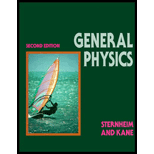
Concept explainers
(a)
The room temperature resistance of the aluminum wire.
(a)
Answer to Problem 63E
The room temperature resistance of the aluminum wire is
Explanation of Solution
Given that the length of the wire is
Write the expression for the resistance in terms of dimensions of the conductor.
Here,
Write the expression for the cross sectional area of the wire.
Here,
Use equation (II) in (I).
Conclusion:
Substitute
Therefore, the room temperature resistance of the aluminum wire is
(b)
The radius of the copper wire with same resistance as of aluminum.
(b)
Answer to Problem 63E
The radius of the copper wire with same resistance as of aluminum is
Explanation of Solution
Solve equation (III) for
It is obtained that the resistance is
Conclusion:
Substitute
Therefore, the radius of the copper wire with same resistance as of aluminum is
(c)
To compare the weight of aluminum wire and copper wire.
(c)
Answer to Problem 63E
The weight of aluminum is
Explanation of Solution
Given that the length of both wires is
Write the expression for the mass in terms of the density.
Here,
Write the expression for the volume of the wire.
The ratio of weights will be equal to the ratio of masses of the two wires.
Here,
Use the expression for the volume in equation (VII) (consider the equal lengths of the wire).
Conclusion:
Substitute
Therefore, the weight of aluminum is
Want to see more full solutions like this?
Chapter 17 Solutions
General Physics, 2nd Edition
- Although caution must be used in applying ρ = ρ0(1 + αΔT) and R = R0(1 + αΔT) for temperature changes greater than 100 °C , for tungsten, the equations work reasonably well for very large temperature changes. A tungsten filament at 20 °C has a resistance of 0.350 Ω . What would the resistance be if the temperature is increased to 2850 °C ?arrow_forwardConsider a portable electric blanket that runs on a 4.5 V battery. If you use copper wire with a 0.5 mm diameter as the heating element, how long should the wire be (in unit of meters) if you want to generate 15 W of heating power? (Take the resistivity of the copper wire as p= 1.7 x 10^(-8) Ω.m)arrow_forwardCalculate the resistance of an annealed copper wire of 710 m long and a diameter of 128 mils at 20 0 C. What will be the resistance of this wire if it is drawn down to one-half of the cross-section without change in volume and material? Please answer with a complete solution.arrow_forward
- consider a conducting wire made of copper. copper has a carrier density of 8.5x10^28 carriers/m^3 and an electrical resistivity of 1.7x10^-8 ohms*m and a charge of 1e/carrier. If a potential difference of 12V is applied between the ends of a copper wire that is 100m long and 1.0mm in diameter, how much current will flow?arrow_forwardA copper transmission line is to be replaced by one of aluminum having the same total resistance. If the cross-sectional area of the copper wire is 500MCM, what would be the cross-sectional area of the new aluminum wire?arrow_forwardAn electronic device designed to operate at any temperature in the range from −10.0 °C to 55.0 °C contains pure carbon resistors. By what factor does their resistance increase over this range?arrow_forward
- Two conductors are made of the same material and have the same length. Conductor A is a solid wire of diameter 1.9 mm. Conductor B is a hollow tube of outside diameter 2.9 mm and inside diameter 1.9 mm. What is the resistance ratio RA/RB, measured between their ends?arrow_forwardA piece of material with a square cross-section measuring 1 mm on each side has a length of 1 m. What is the resistance of this material if it were made of aluminium? Fused quartz? Finally, calculate the current through each piece of material if a potential difference of 1 volt is applied over its length.arrow_forwardWhat resistance, R, should be placed in series with the galvanometer, G, if it is to show a full deflection when the potential across the resistor is 6 V. The maximum current through the galvanometer is 250 mA and its internal resistance is 3 Ω. (a) 24 Ω (b) 23 Ω (c) 3 Ω (d) 5.25 Ω (e) 21arrow_forward
- The temperature coefficient of resistivity for the metal gold is 0.0034 (C°)-1, and for tungsten it is 0.0045 (C°)-1. The resistance of a gold wire increases by 5.3 percent due to an increase in temperature. For the same increase in temperature, what is the percentage increase in the resistance in a tungsten wire?arrow_forwardThe temperature coefficient of a certain conducting material is 4.78 × 10-3 (°C)-1. (a) At what temperature would the resistance be 3 times the resistance at 20.0°C? (Use 20.0°C as the reference point in ρ-ρ0=ρ0α(T-T0).) (b) Does this temperature hold for all copper conductors, regardless of shape or size?arrow_forwardA person standing barefoot on the ground 20 m from the point of a lightning strike experiences an instantaneous potential difference of 300 V between his feet. If we assume a skin resistance of 1.0 kΩ, how much current goes up one leg and back down the other?arrow_forward
 Principles of Physics: A Calculus-Based TextPhysicsISBN:9781133104261Author:Raymond A. Serway, John W. JewettPublisher:Cengage Learning
Principles of Physics: A Calculus-Based TextPhysicsISBN:9781133104261Author:Raymond A. Serway, John W. JewettPublisher:Cengage Learning Physics for Scientists and Engineers: Foundations...PhysicsISBN:9781133939146Author:Katz, Debora M.Publisher:Cengage Learning
Physics for Scientists and Engineers: Foundations...PhysicsISBN:9781133939146Author:Katz, Debora M.Publisher:Cengage Learning

